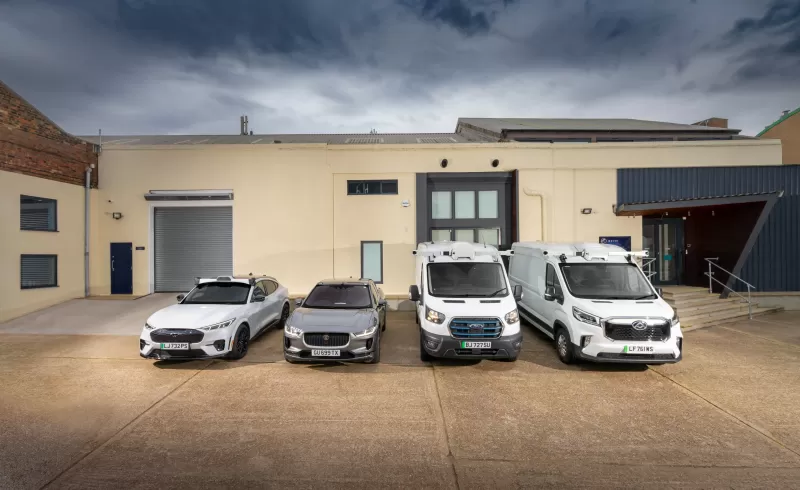Wayve CEO Reveals Secrets to Scaling Autonomous Driving Technology

Alex Kendall, the co-founder and CEO of Wayve, is optimistic about bringing his autonomous vehicle startup's technology to the market. He believes that sticking to their strategy of developing cost-effective, hardware-agnostic automated driving software will be key. This software can be used not just for advanced driver-assistance systems (ADAS) but also for robotaxis and robotics.
During Nvidia's GTC conference, Kendall outlined a strategy that focuses on an end-to-end data-driven learning approach. This means the system directly translates what it "sees" through sensors like cameras into driving actions, such as braking or turning. This method eliminates the need for HD maps or rules-based software, which were common in earlier autonomous vehicle (AV) technologies.
This approach has caught the eye of investors. Since its launch in 2017, Wayve has raised over $1.3 billion in the last two years. The company plans to license its self-driving software to automotive and fleet partners, including companies like Uber. Although no automotive partnerships have been announced yet, a Wayve spokesperson told TechCrunch that they are in "strong discussions" with multiple original equipment manufacturers (OEMs) to integrate their software into various vehicle types.
The affordability of Wayve's software is a major selling point in these negotiations. Kendall mentioned that OEMs can integrate Wayve's ADAS into new production vehicles without needing to invest in additional hardware, as the technology works with existing sensors like surround cameras and radar.
Wayve's software is also "silicon-agnostic," meaning it can run on any GPU that OEM partners already use in their vehicles. However, the startup's current development fleet uses Nvidia's Orin system-on-a-chip.
"Entering into ADAS is really critical because it allows you to build a sustainable business, to build distribution at scale, and to get the data exposure to be able to train the system up to Level 4," Kendall said during his Wednesday presentation. A Level 4 driving system can navigate an environment autonomously under certain conditions without human intervention.
Wayve plans to first commercialize its system at the ADAS level. The startup's AI driver is designed to function without lidar, a sensor that uses laser light to create detailed 3D maps, which many companies developing Level 4 technology consider essential.
Wayve's approach to autonomy is similar to Tesla's, which also uses an end-to-end deep learning model to enhance its self-driving software. Like Tesla, Wayve aims to use a widespread rollout of ADAS to gather data that will help its system achieve full autonomy. Tesla's "Full Self-Driving" software can handle some automated driving tasks but isn't fully autonomous, though the company plans to launch a robotaxi service this summer.
A key difference between Wayve and Tesla is that while Tesla relies solely on cameras, Wayve is open to using lidar to achieve near-term full autonomy. "Longer term, there's certainly opportunity when you do build the reliability and the ability to validate a level of scale to shrink that sensor suite down further," Kendall said. "It depends on the product experience you want. Do you want the car to drive faster through fog? Then maybe you want other sensors like lidar. But if you're willing for the AI to understand the limitations of cameras and be defensive and conservative as a result? Our AI can learn that."
Kendall also introduced GAIA-2, Wayve's latest generative world model designed for autonomous driving. This model trains the driver using vast amounts of real-world and synthetic data across various tasks. By processing video, text, and other actions together, Kendall says it allows Wayve's AI driver to be more adaptive and human-like in its driving behavior.
"What is really exciting to me is the human-like driving behavior that you see emerge," Kendall said. "Of course, there's no hand-coded behavior. We don't tell the car how to behave. There's no infrastructure or HD maps, but instead, the emergent behavior is data-driven and enables driving behavior that deals with very complex and diverse scenarios, including scenarios it may never have seen before during training."
Wayve shares a similar philosophy with autonomous trucking startup Waabi, which also pursues an end-to-end learning system. Both companies focus on scaling data-driven AI models that can generalize across different driving environments and use generative AI simulators to test and train their technology.
Related article
 Google Relaunches AI-Powered 'Ask Photos' with Improved Speed Features
Following a temporary halt in testing, Google is relaunching its AI-driven "Ask Photos" search functionality in Google Photos with significant enhancements. Powered by Google's Gemini AI technology, this innovative feature helps users locate specific
Google Relaunches AI-Powered 'Ask Photos' with Improved Speed Features
Following a temporary halt in testing, Google is relaunching its AI-driven "Ask Photos" search functionality in Google Photos with significant enhancements. Powered by Google's Gemini AI technology, this innovative feature helps users locate specific
 Microsoft hosts xAI's advanced Grok 3 models in new AI collaboration
Earlier this month, my *Notepad* investigative journalism uncovered Microsoft's plans to integrate Elon Musk's Grok AI models - revelations that have now been officially confirmed. Today at Microsoft's annual Build developer conference, company execu
Microsoft hosts xAI's advanced Grok 3 models in new AI collaboration
Earlier this month, my *Notepad* investigative journalism uncovered Microsoft's plans to integrate Elon Musk's Grok AI models - revelations that have now been officially confirmed. Today at Microsoft's annual Build developer conference, company execu
 Apple Teams Up with Anthropic to Develop AI Coding Tool for Xcode
Apple and Anthropic Collaborate on AI-Powered Coding Assistant
According to Bloomberg, Apple is developing an advanced AI coding assistant that will integrate directly into Xcode, its flagship development environment. This collaboration with Anthrop
Comments (41)
0/200
Apple Teams Up with Anthropic to Develop AI Coding Tool for Xcode
Apple and Anthropic Collaborate on AI-Powered Coding Assistant
According to Bloomberg, Apple is developing an advanced AI coding assistant that will integrate directly into Xcode, its flagship development environment. This collaboration with Anthrop
Comments (41)
0/200
![EvelynHarris]() EvelynHarris
EvelynHarris
 July 27, 2025 at 9:18:39 PM EDT
July 27, 2025 at 9:18:39 PM EDT
Wow, Wayve’s approach to hardware-agnostic software sounds like a game-changer! Curious how it’ll compete with the big players in autonomous driving. 🚗


 0
0
![DanielRodriguez]() DanielRodriguez
DanielRodriguez
 April 22, 2025 at 2:33:48 AM EDT
April 22, 2025 at 2:33:48 AM EDT
Alex Kendall's insights into scaling autonomous driving tech are mind-blowing! 🤯 His focus on cost-effective, hardware-agnostic solutions is spot on. Can't wait to see Wayve's tech on the roads soon. Just hope they don't skimp on safety features, right? Keep up the great work, Alex! 🚀


 0
0
![DouglasPerez]() DouglasPerez
DouglasPerez
 April 20, 2025 at 12:59:56 AM EDT
April 20, 2025 at 12:59:56 AM EDT
¡Las revelaciones del CEO de Wayve, Alex Kendall, sobre la escalabilidad de la tecnología de conducción autónoma son impresionantes! 😲 Su enfoque en soluciones de software rentables y agnósticas al hardware es perfecto. No puedo esperar para ver la tecnología de Wayve en las carreteras. Solo espero que no escatimen en las características de seguridad, ¿verdad? ¡Sigan con el gran trabajo, Alex! 🚀


 0
0
![AlbertThomas]() AlbertThomas
AlbertThomas
 April 18, 2025 at 12:50:30 AM EDT
April 18, 2025 at 12:50:30 AM EDT
웨이브의 CEO인 알렉스 켄달이 자율주행 기술의 확장 비밀을 공개했는데 정말 놀랍네요! 😲 비용 효율적이고 하드웨어에 구애받지 않는 소프트웨어 개발에 집중하는 것이 정말 멋지다고 생각해요. 빨리 도로에서 보고 싶어요. 안전 기능에 타협하지 말아주세요! 화이팅! 🚀


 0
0
![LarryEvans]() LarryEvans
LarryEvans
 April 16, 2025 at 12:45:43 PM EDT
April 16, 2025 at 12:45:43 PM EDT
Le PDG de Wayve qui révèle des secrets pour scaler la technologie de conduite autonome, c'est super inspirant ! J'aime leur focus sur des solutions économiques et agnostiques au matériel. Hâte de voir ça sur les routes ! 🚀 On peut avoir une démo bientôt ?


 0
0
![PaulBrown]() PaulBrown
PaulBrown
 April 15, 2025 at 3:21:00 PM EDT
April 15, 2025 at 3:21:00 PM EDT
Wayveの自動運転へのアプローチは有望に聞こえますが、本当にすべてのハードウェアで機能させることができるのでしょうか?🤔 コスト効率の良い解決策に焦点を当てているのは素晴らしいですが、私は懐疑的です。それでも、彼らが成功すれば、すべてが変わるかもしれませんね!


 0
0

Alex Kendall, the co-founder and CEO of Wayve, is optimistic about bringing his autonomous vehicle startup's technology to the market. He believes that sticking to their strategy of developing cost-effective, hardware-agnostic automated driving software will be key. This software can be used not just for advanced driver-assistance systems (ADAS) but also for robotaxis and robotics.
During Nvidia's GTC conference, Kendall outlined a strategy that focuses on an end-to-end data-driven learning approach. This means the system directly translates what it "sees" through sensors like cameras into driving actions, such as braking or turning. This method eliminates the need for HD maps or rules-based software, which were common in earlier autonomous vehicle (AV) technologies.
This approach has caught the eye of investors. Since its launch in 2017, Wayve has raised over $1.3 billion in the last two years. The company plans to license its self-driving software to automotive and fleet partners, including companies like Uber. Although no automotive partnerships have been announced yet, a Wayve spokesperson told TechCrunch that they are in "strong discussions" with multiple original equipment manufacturers (OEMs) to integrate their software into various vehicle types.
The affordability of Wayve's software is a major selling point in these negotiations. Kendall mentioned that OEMs can integrate Wayve's ADAS into new production vehicles without needing to invest in additional hardware, as the technology works with existing sensors like surround cameras and radar.
Wayve's software is also "silicon-agnostic," meaning it can run on any GPU that OEM partners already use in their vehicles. However, the startup's current development fleet uses Nvidia's Orin system-on-a-chip.
"Entering into ADAS is really critical because it allows you to build a sustainable business, to build distribution at scale, and to get the data exposure to be able to train the system up to Level 4," Kendall said during his Wednesday presentation. A Level 4 driving system can navigate an environment autonomously under certain conditions without human intervention.
Wayve plans to first commercialize its system at the ADAS level. The startup's AI driver is designed to function without lidar, a sensor that uses laser light to create detailed 3D maps, which many companies developing Level 4 technology consider essential.
Wayve's approach to autonomy is similar to Tesla's, which also uses an end-to-end deep learning model to enhance its self-driving software. Like Tesla, Wayve aims to use a widespread rollout of ADAS to gather data that will help its system achieve full autonomy. Tesla's "Full Self-Driving" software can handle some automated driving tasks but isn't fully autonomous, though the company plans to launch a robotaxi service this summer.
A key difference between Wayve and Tesla is that while Tesla relies solely on cameras, Wayve is open to using lidar to achieve near-term full autonomy. "Longer term, there's certainly opportunity when you do build the reliability and the ability to validate a level of scale to shrink that sensor suite down further," Kendall said. "It depends on the product experience you want. Do you want the car to drive faster through fog? Then maybe you want other sensors like lidar. But if you're willing for the AI to understand the limitations of cameras and be defensive and conservative as a result? Our AI can learn that."
Kendall also introduced GAIA-2, Wayve's latest generative world model designed for autonomous driving. This model trains the driver using vast amounts of real-world and synthetic data across various tasks. By processing video, text, and other actions together, Kendall says it allows Wayve's AI driver to be more adaptive and human-like in its driving behavior.
"What is really exciting to me is the human-like driving behavior that you see emerge," Kendall said. "Of course, there's no hand-coded behavior. We don't tell the car how to behave. There's no infrastructure or HD maps, but instead, the emergent behavior is data-driven and enables driving behavior that deals with very complex and diverse scenarios, including scenarios it may never have seen before during training."
Wayve shares a similar philosophy with autonomous trucking startup Waabi, which also pursues an end-to-end learning system. Both companies focus on scaling data-driven AI models that can generalize across different driving environments and use generative AI simulators to test and train their technology.
 Google Relaunches AI-Powered 'Ask Photos' with Improved Speed Features
Following a temporary halt in testing, Google is relaunching its AI-driven "Ask Photos" search functionality in Google Photos with significant enhancements. Powered by Google's Gemini AI technology, this innovative feature helps users locate specific
Google Relaunches AI-Powered 'Ask Photos' with Improved Speed Features
Following a temporary halt in testing, Google is relaunching its AI-driven "Ask Photos" search functionality in Google Photos with significant enhancements. Powered by Google's Gemini AI technology, this innovative feature helps users locate specific
 Microsoft hosts xAI's advanced Grok 3 models in new AI collaboration
Earlier this month, my *Notepad* investigative journalism uncovered Microsoft's plans to integrate Elon Musk's Grok AI models - revelations that have now been officially confirmed. Today at Microsoft's annual Build developer conference, company execu
Microsoft hosts xAI's advanced Grok 3 models in new AI collaboration
Earlier this month, my *Notepad* investigative journalism uncovered Microsoft's plans to integrate Elon Musk's Grok AI models - revelations that have now been officially confirmed. Today at Microsoft's annual Build developer conference, company execu
 Apple Teams Up with Anthropic to Develop AI Coding Tool for Xcode
Apple and Anthropic Collaborate on AI-Powered Coding Assistant
According to Bloomberg, Apple is developing an advanced AI coding assistant that will integrate directly into Xcode, its flagship development environment. This collaboration with Anthrop
Apple Teams Up with Anthropic to Develop AI Coding Tool for Xcode
Apple and Anthropic Collaborate on AI-Powered Coding Assistant
According to Bloomberg, Apple is developing an advanced AI coding assistant that will integrate directly into Xcode, its flagship development environment. This collaboration with Anthrop
 July 27, 2025 at 9:18:39 PM EDT
July 27, 2025 at 9:18:39 PM EDT
Wow, Wayve’s approach to hardware-agnostic software sounds like a game-changer! Curious how it’ll compete with the big players in autonomous driving. 🚗


 0
0
 April 22, 2025 at 2:33:48 AM EDT
April 22, 2025 at 2:33:48 AM EDT
Alex Kendall's insights into scaling autonomous driving tech are mind-blowing! 🤯 His focus on cost-effective, hardware-agnostic solutions is spot on. Can't wait to see Wayve's tech on the roads soon. Just hope they don't skimp on safety features, right? Keep up the great work, Alex! 🚀


 0
0
 April 20, 2025 at 12:59:56 AM EDT
April 20, 2025 at 12:59:56 AM EDT
¡Las revelaciones del CEO de Wayve, Alex Kendall, sobre la escalabilidad de la tecnología de conducción autónoma son impresionantes! 😲 Su enfoque en soluciones de software rentables y agnósticas al hardware es perfecto. No puedo esperar para ver la tecnología de Wayve en las carreteras. Solo espero que no escatimen en las características de seguridad, ¿verdad? ¡Sigan con el gran trabajo, Alex! 🚀


 0
0
 April 18, 2025 at 12:50:30 AM EDT
April 18, 2025 at 12:50:30 AM EDT
웨이브의 CEO인 알렉스 켄달이 자율주행 기술의 확장 비밀을 공개했는데 정말 놀랍네요! 😲 비용 효율적이고 하드웨어에 구애받지 않는 소프트웨어 개발에 집중하는 것이 정말 멋지다고 생각해요. 빨리 도로에서 보고 싶어요. 안전 기능에 타협하지 말아주세요! 화이팅! 🚀


 0
0
 April 16, 2025 at 12:45:43 PM EDT
April 16, 2025 at 12:45:43 PM EDT
Le PDG de Wayve qui révèle des secrets pour scaler la technologie de conduite autonome, c'est super inspirant ! J'aime leur focus sur des solutions économiques et agnostiques au matériel. Hâte de voir ça sur les routes ! 🚀 On peut avoir une démo bientôt ?


 0
0
 April 15, 2025 at 3:21:00 PM EDT
April 15, 2025 at 3:21:00 PM EDT
Wayveの自動運転へのアプローチは有望に聞こえますが、本当にすべてのハードウェアで機能させることができるのでしょうか?🤔 コスト効率の良い解決策に焦点を当てているのは素晴らしいですが、私は懐疑的です。それでも、彼らが成功すれば、すべてが変わるかもしれませんね!


 0
0





























